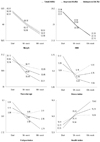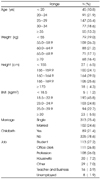Abstract
This study was carried out to analyze the effect of a diet program for adult women on weight loss, BMI, eating habits, sleeping habits, health related indices. The subjects was 415 participants of the 10 weeks (20 time participation program). The data was collected by basic somatometry and HRV (Heart Rate Variability) / APG (Accelerated Plethysmograph) Analyzer. The average age, height, weight and BMI were 28.6 years, 162.1 cm, 62.8 kg and 23.9 kg/m2, respectively. Their body types by BMI were under weight (1.2%), normal (45.8%), overweight (24.8%), mild obesity (22.7%) and obesity (5.5%). There were significant reductions of average weight (4.6 kg) and average BMI (1.75 kg/m2) on the 10th week. There were positive changes in vascular age (50.4%), stress index (44.6%), fatigue index (43.9%), health index (54.5%) of the subjects during the program. There was a meaningful difference of the average variation for the vascular age, stress index, fatigue index, and health index between two groups; one improving the eating habit and the other did not (p < 0.05), and also there was a meaningful difference of the average variation for the fatigue index in both groups improving the sleeping habit (p < 0.05), but was not a meaningful difference of the average variation for the vascular age, stress index, and health index between two groups. There was a meaningful difference of the average variation for the vascular age, stress index, fatigue index, and health index between two groups improving both eating and sleeping habit (p < 0.05). In conclusion, the weight loss program was effective on the weight loss and BMI reduction and health related indices.
Figures and Tables
Table 4
Distribution of subjects improved for eating habits and sleeping habits by weight loss program

References
1. Chin JH, Chang KJ. College students' attitude toward body weight control, health-related lifestyle and dietary behavior by self-perception on body image and obesity index. J Korean Soc Food Sci Nutr. 2005; 34(10):1559–1565.
2. Choi MS, Kim MS. The effect of nutritional education and exercise intervention on reducing weight of obese women. Korean J Community Living Sci. 2006; 17(4):57–66.
3. Chun KS, Shin SH, Kim SH, Koh JK, Kim IY, Hwang HS, Park HK. Association of metabolic syndrome with the pulse wave velocity. Korean J Med. 2007; 73(4):384–392.
4. Han JS, Park YO, Zhoh CK. The effect of high frequency treatment and meridian massage on the abdominal fat pattern of obesity women. J Korean Soc Esthet Cosmeceutics. 2010; 6(1):1–8.
5. Heo EY. The effect for abdominal obesity management using the aroma oil, ultrasonic wave and low-frequency for adult women. Sungshin Women's University;2005. 44–51. MS thesis.
6. Hong AR. The effect of stress easing and obesity administration after getting the hand energy beauty face lifting therapy. Daejeon University;2010. 57–68. MS thesis.
7. Jeon EJ. Health related characteristics and eating habits of middle-aged woman according to the degree of obesity. Wonkwang University;2011. 15–26. MS thesis.
8. Jeon YS, Ahn HS. Influence of subjective perception of body image and weight management on obesity stress in college women. J Korean Soc Esthet Cosmeceutics. 2006; 1(2):13–26.
9. Jeong KS. Summary of HRV. J Korean Acad Fam Med. 2004; 25(11):Suppl. 528–532.
10. Jung EJ. The effects of high frequency therapy on abdomen circumfence changes of women obesity. Chungang University;2006. 28–44. MS thesis.
11. Jung YJ. A study of weight control, dietary habits and nutrition education with different body image in female college students. Dongguk University;2009. 20–40. MS thesis.
12. Jung YK. Effects and development of the body weight control education program of female college students. Kosin University;2006. 48–55. Ph.D dissertation.
13. Kim EJ, Hwang HJ. Effects of a nutrition education and exercise program of overweight or obese female adults on nutritional and health status. J Korean Soc Food Sci Nutr. 2010; 39(1):78–84.
14. Kim HK, Kim JH. Relationship between stress and eating habits of adults in Ulsan. Korean J Nutr. 2009; 42(6):536–546.
15. Kim HK, Kim MJ. Effects of weight control program on dietary habits and blood composition in obese middle-aged women. Korean J Nutr. 2010; 43(3):273–284.
16. Kim KA, Ahn GJ, Kim KW. Analysis of dietary habit, eating disorder and needs for nutrition education programs by weight control attempts among female college students. J Korean Soc Study Obes. 2004; 13(4):248–260.
17. Kim MH. Evaluations of anthropometric measure, blood profile, dietary habits and nutrient intakes in obese adults by obesity degree. Chungang University;2007. 20–49. MS thesis.
18. Kwon SM, Kang HJ, Yim YK, Lee YH. Analysis of arterial stiffness by age using pulse waveform measurement of 5-levels graded pressure. Korean J Acupunct. 2010; 27(2):107–120.
19. Kwon YS. A study on obesity stress and related factors among female college students. J Korean Acad Community Health Nurs. 2008; 19(3):431–432.
20. Lee BM. The effects of aroma massage with behavior modification treatment on abdominal obesity. Kyonggi University;2009. 38–48. MS thesis.
21. Lee HJ. The relation of heart rate variability and body weight change in conducting community-based obesity control program. Graduate School of Public Health, Ajou University;2010. 20–26. Master Thesis.
22. Lee HJ, Choi MR, Koo JO. A study of body image, weight control and dietary habits with different BMI in female high school students. Korean J Community Nutr. 2005; 10(6):805–813.
23. Lee HS, Lee JW, Chang NS, Kim JM. The effect of nutrition education and excercise program on body composition and dietary intakes, blood lipid and physical fitness in obese women. Korean J Nutr. 2009; 42(8):759–769.
24. Lee HS. The effect of nutrition education and exercise intervention on nutrient intakes, body composition, serum lipids and physical fitness in obese women. Ewha Womans University;2010. 26–30. 47–52. MS thesis.
25. Lee YJ, Kim MS, Kim BT, Kwak TH, Shim JY, Lee HR. Heart rate variability in metabolic syndrome. J Korean Acad Fam Med. 2002; 23(12):1432–1439.
26. Lee YJ, Hwang DS, Lee CH, Lee KS. A study on characters of heart rate variability in young overweight and obese woman. J Soc Korean Med Obes Res. 2008; 8(1):63–70.
27. Ministry of Health and Welfare. Korea Centers for Disease Control and Prevention. Korea health statistics 2011 : Korea national health and nutrition examination survey (KNHANES V-2). Seoul: Ministry of Health and Welfare;2012. p. 404–414.
28. Park SY. The elationship between eating attitude and level of depression, anxiety and stress of women visiting weight management clinic. Yonsei University;2005. 12–16. MS thesis.
29. Park SY. A study on the implementation of arterial pulse wave analysis system using oxygen saturation by pulse oximetry (SpO2) sensor. Graduate School, Kangwon National University;2006. 103–105. Doctor Thesis.
30. Rhee SM, Kim HW, Park YH, Kim JC, Park JW, Rhee SJ, Nyamdorj S, Ahn JM. Effect of patient's breathing pattern on the stress changes in third molar extraction. J Korean Assoc Oral Maxillofac Surg. 2007; 33(5):485–493.
31. Seo JH. Evaluation of wight control program for obese female college students. J Korean Soc Food Sci Nutr. 2005; 34(9):1381–1387.
32. Suh SK. The relationship between hypertension and stress measured by heart rate variability in a rural area, korea. Graduate School, Hanyang Uniersity;2007. 40–48. Doctor Thesis.
33. Sung MJ, Chang KJ. Correlations among life stress, sleep, anthropometric measurement and nutrient intakes of college students. J Korean Soc Food Sci Nutr. 2007; 36(7):840–848.
34. Yang KM. Relationship between the assessment of obesity and cardiovascular diseases. Food Ind Nutr. 2002; 7(2):1–8.
35. Yoon YS, Park HS. Obesity and chronic kidney disease. Korean J Obes. 2009; 18(4):123–130.
36. Yun HK, Kim HS, Chang NS. Diet quality index-international score is correlated with weight loss in female college students on a weight management program. Korean J Nutr. 2009; 42(5):453–463.




 PDF
PDF ePub
ePub Citation
Citation Print
Print










 XML Download
XML Download